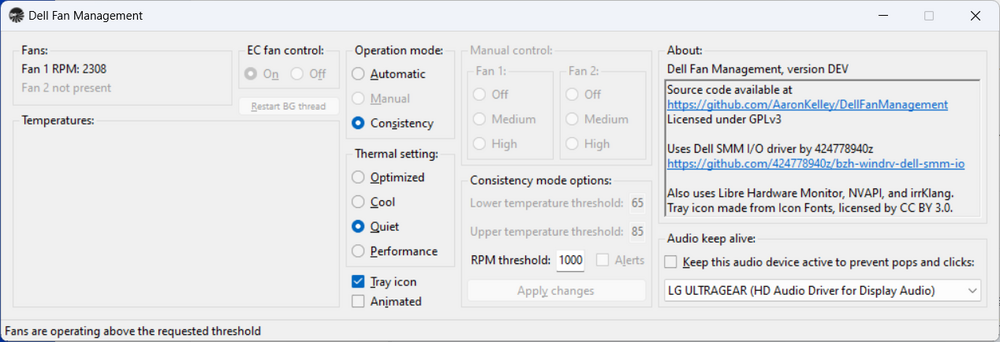-
Posts
2,215 -
Joined
-
Days Won
31
Content Type
Profiles
Forums
Events
Posts posted by Aaron44126
-
-
See:
(Sorry the pictures aren't working, but the needed commands are there.)
-
13 minutes ago, chieukhanhok said:
If I get a P4000 card from a Dell 7720... Do I need to flash the vBIOS?
Yes, unless you plan to use Linux, you will need to flash the vBIOS for Quadro P3000/P4000/P5000 to avoid the ACPI BSOD when booting Windows. (You can boot to Linux using a "live USB" environment to do the flash, Linux will not have trouble booting.) Make sure that you have Optimus enabled if you have a LVDS display panel.
@TheQuentincc has a working vBIOS image here.
-
7 minutes ago, MyPC8MyBrain said:
it is inevitable that intel will shortly release 16 efficiency 16 performance for mobile chips too,
I think this is pretty unlikely, we'd sooner see a 8P+24E configuration. If you're going to raise the core count, adding more E cores is the only thing that makes sense. Four E cores will outperform one P core for a multi-threaded load (those are about equal in terms of physical space and power required). Single-threaded loads of course do better on a P core, but for single/low-thread counts, there's no real need for more P cores...
1 hour ago, MyPC8MyBrain said:so what happens to all other board traces if only ram traces are epitomized for lower latency and other are not?
I'd say there are no traces with as much impact as the RAM traces, but PCH/PCIe could maybe use attention at some point as bandwidth increases for PCIe 5/6...?
1 hour ago, MyPC8MyBrain said:i wish manufactures focused on optimizing their hardware little more like apple rather then follow a pointless eye candy hype for a premium,
+1, Apple seems to be the only one capable of making a good mobile-first CPU these days. Too bad so many other compromises come with using a Mac.
-
 3
3
-
 1
1
-
-
CAMM is making progress towards becoming the next standard, replacing SODIMM. It could be approved in late 2023 and show up in other devices in 2024.
https://www.tomshardware.com/news/camm-to-usurp-so-dimm-laptop-memory-form-factor-says-jedec-member
https://www.pcworld.com/article/1473126/camm-the-future-of-laptop-memory-has-arrived.html
The "wall" for SODIMM Is somewhere around DDR5/6400.
They're also saying that it could allow for modular LPDDR6 implementations, not requiring that memory to be soldered on.
-
 1
1
-
-
4 hours ago, Inspiron Turbojet said:
11th/12th gen systems don't work well with this program. There is no known interface for manual fan control on these newer systems. The "consistency" mode option that you have selected is just a quick hack that I put in place to prevent the fans from turning off by putting an artificial CPU load on if the fan speed gets too low.
-
 1
1
-
-
3 minutes ago, MyPC8MyBrain said:
before everyone panics... this is a factoring limitation when Microsoft Virtualization-Based Security (VBS) feature is enabled some applications might not work properly ( @Aaron44126 the article i read mentions some features will not work properly when this is enabled one of these is "Manual fan speed control might not work.")
Eh.
1. I have VBS disabled. I have tried it and it causes performance issues for me. Microsoft themselves even recommends disabling it for best gaming performance.
2. The guy in the Reddit thread I linked above reports undervolting working with his XPS with BIOS 1.11.x, broken after the BIOS Update to 1.12.x, and restored after rolling back to BIOS 1.11.x. (I might have the version numbers wrong.) It seems clearly tied to the BIOS (+ microcode) version and not the OS configuration. ...Also, Dell has since released another newer BIOS version for that XPS system that does not allow a BIOS downgrade to a version that allows undervolting.
-
 1
1
-
 1
1
-
-
Huh, I didn't realize that this is out. I am also interested, as an iOS user, I do prefer to do messaging on my PC and I actually use a Mac Mini via VNC to handle iMessage sometimes; a clunky solution that I'd like to do away with.
......But I'm not upgrading to Windows 11 until there is a LTSC version, so, I guess that gives them plenty of time to fix up the bugs 🙂
There are new regulations coming out of Europe that might force Apple to open up their platform a bit, and I'm interested to see what comes from that too. In addition to allowing some form of side-loading on devices, the rumor mill says that Apple is (reluctantly) considering allowing third-party browsers (that don't use the OS-provided Safari rendering engine) and also opening up iMessage in some way to comply with the new regulations. Any such changes are probably at least a year out.
-
 2
2
-
-
47 minutes ago, MyPC8MyBrain said:
this only effects 12th gen cpu?
If they just patched this in November, 13th gen physical design was of course long finished by then, so it will almost certainly get the updated microcode (likely before any laptops even ship to customers).
Anyway. The good thing here is you don't have to upgrade your BIOS. If your system is working good now then you can keep it that way. Good thing Dell put out an update that addressed some of the thermal concerns before they put out one with the undervolt "fix".
For anyone concerned by this, turn off capsule updates in the BIOS and let other users "go first" when a new version comes out to see what happens.
-
Heads up, it looks like Dell might be looking to block undervolting in later firmwares.
https://www.reddit.com/r/DellXPS/comments/1019me5/dell_xps_17_9720_issue_with_undervolting_after/
(This is regarding an XPS system, but of course they share a lot of BIOS code between all models.)
-
Third-party Twitter clients are broken, whether by policy or glitch
-
14 minutes ago, Vaardu said:
... and getting a mounting kit.
So if you look at how LCDs are mounted, there are typically little "tabs" that stick out on the top and bottom of the panel that have screw holes. You can see one in your image right above, partly obscured by the hinge.
These mounting tabs are actually not part of the panel, but just an aluminum thing that "sticks" to the back. They can be pretty easily removed and "migrated" to a new panel as long as the physical dimensions are the same.
Here is an image of the back of a panel and I try to illustrate what I am talking about:
-
 1
1
-
-
BIOS update 1.19.0.
- Firmware updates to address security vulnerabilities including (Common Vulnerabilities and Exposures - CVE) such as CVE-2022-30704.
- Fixed the issue where the system cannot boot after the BIOS update.
- Fixed the issue where the Dell logo is displayed incorrectly when the system boots to the operating system and the system lid is closed.
- Fixed the issue where the system auto wakes up on days not selected by you in the Auto On Time function in the BIOS setup.
- Fixed the issue where the brightness function stops working on the systems with the Linux operating system.https://www.dell.com/support/home/en-us/drivers/driversdetails?driverid=R75HT
-
 1
1
-
-
Microsoft is supporting Windows Server 2008 R2 until at least January 2024 for Azure customers, and I am assuming that those patches will be able to be shoved onto Windows 7 somehow, since the codebase and patches are largely the same?
-
3 minutes ago, MyPC8MyBrain said:
lets go Aaron \ o /
Ha, I gave it a go with the Precision 7560 in 2021 but came up blank. 😛
(I was first/only to come up with a solution to read the fan RPM values though...)
[Edit] I keep writing "last year" when I mean 2021...
-
 1
1
-
-
1 hour ago, dude123 said:
Which mechanism governs this?
I can tell you that the fans are run by the embedded controller. Dell has an all-new implementation for fan control that was introduced with the Tiger Lake systems in 2021. (I think that it is basically the same implementation in all of their laptops except for Alienware, though I have only personally used Precision laptops that have Tiger Lake or later.) AFAIK, no one has found a way to manipulate it into manual control of any sort yet. I will eagerly integrate any solution found (Windows or Linux!) into Dell Fan Management.
-
 1
1
-
-
24 minutes ago, Vaardu said:
The LCD doesn't appear to be secured through the screws on the tabs but I can see an adhesive tab (I think) on one corner. I'm not sure what is really going on here.
Huh. That is a surprise. I know that Dell has fully switched to adhesive for newer models (Precision 7X70+), but I have removed both the Precision 7530 and 7560 displays and they were just screws. In any case, if they have used adhesive in your system, at least the screw holes are still there so you can mount another display without having to use adhesive.
-
1 hour ago, dude123 said:
I will be glad for any recommendations with this. Thank you
Starting with last year's systems (11th gen / Precision 7X60), the fans are much more hesitant to kick in; you need a sustained load for a minute or two before they ramp up to max. And at least in my Precision 7770, "max" is not that high, just around 3600 RPM (where previous systems I have seen hitting 4500-4800).
For ThrottleStop to work, make sure that you have the CPU virtualization support turned off in BIOS settings. (It is on by default, I believe.)
In any case, I turn off turbo boost to keep temperatures under control when I am not running a high-CPU load. (I have an "article" about it linked from my sig.)
-
 1
1
-
-
Just saw this in another thread 😕
https://videocardz.com/newz/msi-afterburner-software-without-msi-support-project-is-probably-dead
(I wonder if you can adjust power limits using any other tool, like NVIDIA Inspector maybe?)
[Edit]
MSI response.
-
3 hours ago, carly said:
So the first issue to access a Windows 10 - 'Redstone 1' v. 14393-1607 ISO is unfortunately the same.
Internet Archive has some old ISOs. I.e.:
-
2 hours ago, KING19 said:
RIP to the last Microsoft OS that we was allowed to control Windows Update without any 3rd party tweaks 😂
I've been wondering about an update manager for Windows 10 (or 11) and never have really tried any of them out. Right now, I just have automatic reboots for updates disabled (by breaking the Windows scheduled task that handles this) and I also pause updates for 4-5 weeks at a time so that I know they will only come in on Patch Tuesday.
Has anyone tried an update manager tool like WuMgr or Windows Update MiniTool to get an experience more like Windows 7 and 8 had?
-
 1
1
-
-
Without registry tweaking you would need to install Windows 10 LTSB 2015 (build 10240) first. That is the only one without an upgrade block. From there you can upgrade to any later version.
LTSB/LTSC ISOs are not as readily available as regular Windows 10 ISOs. My source for ISOs is a Visual Studio subscription. You can also get them from the MS volume license center if your business has access. Otherwise, you may have to resort to “shady sources” but I can give some SHA1 hashes.
Again, if finding LTSB 2015 is a problem but you have a later LTSC image/license, you can upgrade to “regular” Windows 10 and then from there to LTSC using the trick described up top; as long as you are never going backwards with the major build number it should work.
-
7 minutes ago, carly said:
Probably it was 8.0.
Microsoft source: "In-place upgrade from Windows 7, Windows 8.1, or Windows 10 General Availability Channel to Windows 10 LTSC isn't supported. Windows 10 LTSC 2015 didn't block this in-place upgrade path. This issue was corrected in the Windows 10 LTSC 2016 release, which only allows data-only and clean install options."
In fact, there are even Youtube videos that document a registry hack on Windows 10 'general' in order to install a LTSC release.
Therefore I am not sure that makes sense upgrading Windows 8.1 to 21H2 or ealier, i.e. 'Windows 10 General Availability Channel' release because this procedure would not allow to upgrade to any LTSB 2016 or LTSCs, at least with in-place procedure that your post implied.
If you go to my OP, I describe making a change to the "EditionId" value in the registry to allow the upgrade. This is viable and works fine, I have done it at least ten times at this point to switch from a "regular" Windows 10 edition to Windows 10 LTSC in-place. It is not officially supported by Microsoft but I have never encountered any issues with it. My two current daily driver systems were upgraded in this manner over a year ago and are still working fine.
The Microsoft source that you quoted above is exactly what I am talking about. Microsoft allowed Windows 7/8/8.1 users to upgrade to Windows 10 LTSB 2015 by accident. Rather, they failed to put an upgrade block in place. It is not officially supported, but it does work without any registry trickery.
If you're looking for an "officially supported" mechanism to upgrade from non-LTSC to LTSC (without a clean install), there is none.
You could probably use a similar registry trick to allow an upgrade from Windows 7/8/8.1 directly to a later version of Windows 10 LTSB/LTSC. I've never done this so I do not know exactly what values would need to be changed.
-
12 minutes ago, carly said:
Hi Everyone and @Aaron44126!
Are you sure that Windows 8.1 can be upgraded to Windows 10 LTSB 2015 (before eventually migrating to LTSC edition...)?
It is my understanding that upgrade path was limited to Windows 8.
I have personally done such an upgrade but I actually don't recall if I was upgrading from Windows 8 or 8.1. I thought it was 8.1 but I might be mistaken. I do know that Microsoft did not intend to allow any upgrades from old versions of Windows to Windows 10 LTSB, and it is sort of an "accident" that this is allowed for LTSB 2015. It was properly blocked for later versions.
...If Windows 8.1 does not allow an upgrade to Windows 10 LTSB 2015, you could just upgrade to regular Windows 10 (21H2 or earlier) and then upgrade from there to LTSB/LTSC using the procedure that I describe up in the OP.
-
3 hours ago, Vaardu said:
The CPU fan has its dreaded rattling again. Is it possible for the rotor of the fan to lose its magnetism?
For these, the CPU fan is easily swappable without removing anything other than the bottom panel and you can find new ones cheap on eBay, so I'd say just replace it if it is causing you issues.
-
 1
1
-

.thumb.png.e841bc17c8cca329ac53db7523663d9a.png)

The Twitter Debacle
in Off-Topic
Posted
Interesting article on the Twitter "debt payment due soon, what to do?" conundrum.
https://arstechnica.com/tech-policy/2023/01/looming-twitter-interest-payment-leaves-elon-musk-with-unpalatable-options/
Another one just recapping the last few months of Twitter from a sort of "what's it like to work there" perspective.
https://www.theverge.com/23551060/elon-musk-twitter-takeover-layoffs-workplace-salute-emoji